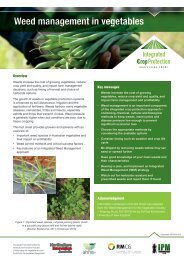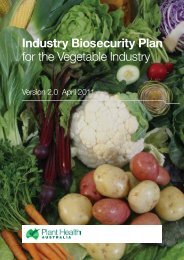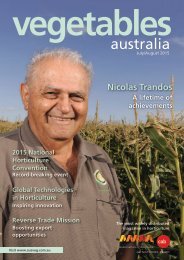vegetables
VA-NovDec2015
VA-NovDec2015
Create successful ePaper yourself
Turn your PDF publications into a flip-book with our unique Google optimized e-Paper software.
35<br />
of our soil and the farming<br />
property,” he said.<br />
While he says there is a place<br />
for organics, Mike believes<br />
there needs to be a change in<br />
consumer awareness around<br />
the growing conditions for<br />
Australian produce.<br />
“A lot of produce is grown<br />
using a lot of organic practices<br />
and we only use chemicals<br />
when there is a major problem.<br />
“We have lots<br />
of controls and<br />
regulations<br />
to put up<br />
with here in<br />
Australia, but<br />
because of<br />
those controls<br />
and regulations<br />
we produce a<br />
very healthy<br />
and safe<br />
product and<br />
we should be<br />
capitalising on<br />
that.”<br />
- Mike Badcock<br />
“As growers, we have to prove<br />
that there are no residues<br />
on our products, and the<br />
transparency with everything we<br />
do allows consumers to trust our<br />
produce.”<br />
EnviroVeg benefits<br />
Mike is a member of the<br />
Australian vegetable industry’s<br />
dedicated environmental<br />
program, EnviroVeg, which<br />
he oversaw in its earlier days<br />
during his time as Chairman<br />
of AUSVEG. He reiterates how<br />
programs such as EnviroVeg are<br />
really important for the industry.<br />
“EnviroVeg is an excellent<br />
scheme with quite a<br />
membership now and another<br />
really good marketing advantage<br />
for us,” he added.<br />
On his property, Mike uses<br />
agronomists and advisers to<br />
minimise his chemical use and<br />
to implement Integrated Pest<br />
Management (IPM) techniques.<br />
This has cut back chemical use<br />
by 60 per cent and is one of<br />
the biggest areas of change in<br />
R&D techniques that Mike has<br />
witnessed.<br />
“We are very much more<br />
chemically and environmentally<br />
friendly now and most farms are<br />
taking this on-board.”<br />
Areas of opportunity<br />
In addition to being a member<br />
of EnviroVeg, Mike foresees<br />
retail market structure,<br />
innovation with modern<br />
technology and showcasing<br />
Australia’s environmental<br />
credentials overseas as<br />
necessary areas of industry<br />
focus.<br />
“The retail structure affects<br />
the whole supply chain, and<br />
farmers don’t have options<br />
to market their produce. The<br />
industry needs to find ways to<br />
market produce directly from<br />
the grower to the consumer,”<br />
he said.<br />
“In its current state, the<br />
industry is losing out in low<br />
socio-economic areas where<br />
people can get fast food easier<br />
than <strong>vegetables</strong>. People are<br />
only eating two of the five<br />
recommended <strong>vegetables</strong> on<br />
average per day – if we can get<br />
that up to four, then the industry<br />
is effectively doubled and there<br />
is a healthier population.”<br />
Further to expanding the<br />
Australian vegetable market with<br />
increased consumer awareness<br />
and ease of access, the next<br />
greatest area of expansion will<br />
be overseas.<br />
“There are great opportunities<br />
in the growing Asian and United<br />
Arab Emirates markets in the<br />
higher level product side, which<br />
we are producing under the top<br />
level conditions of Australia.<br />
If we can start capitalising on<br />
high-end material overseas,<br />
then we are taking more<br />
products out of Australia<br />
which gives us more power in<br />
negotiating the product left in<br />
Australia.”<br />
Showcasing quality<br />
produce<br />
Mike believes that the top level<br />
growing conditions of Australian<br />
Photography by Belle Young<br />
produce is going to be a big<br />
advantage in the Australian<br />
vegetable industry’s access to<br />
burgeoning export markets, and<br />
modern technology will be the<br />
way forward in accessing this<br />
information.<br />
“We have lots of controls and<br />
regulations to put up with here<br />
in Australia, but because of<br />
those controls and regulations<br />
we produce a very healthy and<br />
safe product and we should be<br />
capitalising on that,” he said.<br />
“Something like QR codes<br />
can show where, how and<br />
who produced the product.<br />
Consumers are now crying out<br />
for more knowledge on how their<br />
food was produced and who<br />
produced it.<br />
“Australian grown labels were<br />
fought against initially; people<br />
thought the only factor was<br />
price, but now this label has<br />
really taken off and people are<br />
demanding Australian grown<br />
produce.”<br />
Overall, Mike encapsulates<br />
what it is like to be involved in<br />
the Australian vegetable industry<br />
right now in one sentence: “It’s<br />
an exciting world at this time<br />
and we should be capitalising<br />
on it.”<br />
Vegetables Australia November/December 2015





